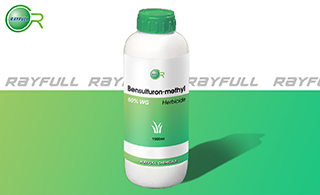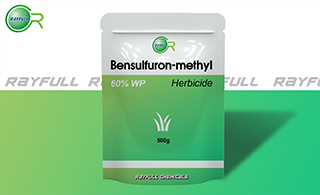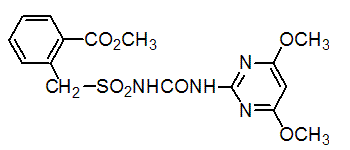BENSULFURON-METHYL
  ЬРаЧ»ЗВЎ ЬРаЧ»ЗВЎ
Introduction: A pyrimidinylsulfonylurea herbicide used to control annual and perennial weeds and sedges, such as pigweed, chickweed, wild mustard, stinkgrass, barnyardgrass, rice flatsedge, dwarf umbrella grass, nut-grass, creeping water primrose in cereals especially wheat and rice field.
Common name: Bensulfuron-methyl
Another name: Londax, Methyl bensulfuron, Bensulfuron methyl ester, Bianmihuanglong, Bensulfuron Me, Bensulfuronmethyl, etc.
Chemical name:
methyl ҰБ-[(4,6-dimethoxypyrimidin-2-ylcarbamoyl)sulfamoyl]-o-toluate
Empirical formula: C16H18N4O7S
Structural formula:

Mol. Weight: 410.4 g/mol
CAS No.: 83055-99-6
Specifications
Leading Bensulfuron-methyl supplier
Bensulfuron-methyl 60% WG
Bensulfuron-methyl 60% WP
Bensulfuron-methyl 95% TC
Packing:
BULK PACKING
Solid: 25kg/Bag, 25kg/Drum, 50kg/Drum etc.
SMALL PACKING
Solid: 1kg/Alu bag, 500g/Alu bag, 200g/Alu bag, 100g/Alu bag, 50g/Alu bag, 15g/Alu bag etc.
Customerized packing label
Bensulfuron-methyl FAO standard
Professional registration
HAZARDS IDENTIFICATION
Hazard statement(s)
H317: May cause an allergic skin reaction.
H411: Toxic to aquatic life with long lasting effects.
Precautionary statement(s)
P261: Avoid breathing dust/fume/gas/mist/vapors/spray.
P272: Contaminated work clothing should not be allowed out of the workplace.
P273: Avoid release to the environment.
P280: Wear protective gloves/protective clothing/eye protection/face protection.
P302+P352: IF ON SKIN: wash with plenty of water.
P321: Specific treatment (see ... on this label).
P333+P313: IF SKIN irritation or rash occurs: Get medical advice/attention.
P363: Wash contaminated clothing before reuse.
P391: Collect spillage.
P501: Dispose of contents/container to ...
Supplemental Hazard Statements: none
MAMMALIAN TOXICOLOGY
Acute toxicity: 1) Acute oral LD50 for rat: >5000 a.i.mg/kg. 2) Acute dermal LD50 for rat: >2000 a.i.mg/kg. 3) Inhalation LC50 (4 h) for rat: 7.5 a.i. mg/L. 4) Not irritant to skin (rabbits). 5) Not irritant to eyes (rabbits). 6) Not a skin sensitiser (guinea pigs). NOEL: (1 y) for male dogs is 21.4 mg/kg b.w. daily; reproduction (2 generation) NOEL for male rats is 20 mg/kg b.w. daily; teratogenicity NOEL for rabbits is 300 mg/kg b.w. daily. No developmental toxicity or teratogenicity.
ADI: 0.2 mg/kg b.w./day [Dog, SF=100]
Classification:
Toxicity class WHO (a.i.): U (Unlikely to present an acute hazard)
US EPA Classification (formulation): IV (Caution - Not acutely toxic)
EC Risk Classification: Xn - Harmful: R43; N - Dangerous for the environment: R50, R53
ECOTOXICOLOGY
Effect on birds: low toxicity to birds, acute oral LD50 for Mallard ducks is >2510 a.i.mg/kg. Effect on fish: moderate toxicity to fish, acute 96 hour LC50 for Rainbow trout is >66 a.i.mg/L. Effect on aquatic invertebrates: low toxicity to aquatic invertebrates, acute 48 hour EC50 for Daphnia magna is 130 a.i.mg/L. Effect on algae: moderate toxicity to algae, acute 72 hour EC50 for Raphidocelis subcapitata is 0.02 a.i.mg/L. Effect on honeybees: low-moderate toxicity to honeybees, contact acute 48 hour LD50 is >100 a.i.ҰМg/bee; oral acute 48 hour LD50 is >51.4 a.i.ҰМg/bee. Effect on earthworms: low toxicity to earthworms, acute 14 day LC50 for Eisenia foetida is >1000 a.i.mg/kg.
ENVIRONMENTAL FATE
In aqueous solutions, bensulfuron methyl is most stable under slightly alkaline conditions (pH 8) and degrades slowly under acidic conditions. Bensulfuron methyl is very stable in organic solvents, except methanol and dimethyl sulfoxide. Samples of the bensulfuron methyl wettable powder/premix moisteneg with 2.1% water decomposed after 3 months at temperatures above 45Ўж.
Bensulfuron methyl adsorbs weakly to sandy loam soils and strongly to silt loam soils. Therefore, the mobility classification varied from intermediate to immobile as the percent of organic matter content increased. Bensulfuron methyl is only desorbed slowly.
The half-life of bensulfuron methyl in aerobic soil metabolism studies was 4-20 weeks. This evidence suggests bensulfuron methyl is a moderately residual or persistent pesticide according to the classification system of Harris. The major degradation product is CO2. In sterilized soils the degradation was slower indicating mi robes facilitated, but were not essential for, degradation. No carbon dioxide was produced in sterilized soils, but the amounts of the nonvolatile degradation products increased. The two major nonvolatile metabolites were sulfonamide and pyrimidine amine [2-amino-4,6-dimethoxypyrimidine].
In simulated sunlight, bensulfuron methyl is rapid independent of pH with a half-life of about 4 hours. A large number of photodegradation products were formed, but all were present in low concentrations. The most abundant was beta-lac, suggesting a complete breakdown of the phenyl ring.
The hydrolysis of bensulfuron methyl in the dark was dependent on pH with the half-life greater than 30 days at the most stable pH (i.e., at pH 9, 88-93% of the parent compound remained). The major hydrolysis products were sulfonamide and pyrimidine amine.
Usage: Herbicidal activity of bensulfuron-methyl reported by T. Yayama et al. (Proc. 9th Asian Pacific Weed Sci. Soc. Congr., 1983, p. 554). Introduced by E. I. du Pont de Nemours and Co.; first approval in 1985. Patents: US 4420325. Manufacturers: DuPont; Sannong; Sharda; Shenyang; Sundat. Branched chain amino acid synthesis (ALS or AHAS) inhibitor. Acts by inhibiting biosynthesis of the essential amino acids valine and isoleucine, hence stopping cell division and plant growth. Selectivity is due to rapid metabolism in the crop. Metabolic basis of selectivity reviewed (M. K. Koeppe & H. M. Brown, Agro-Food-Industry, 6, 9-14 (1995)).
Application: Selective systemic herbicide, absorbed by the foliage and roots, with rapid translocation to the meristematic tissues. Selective pre- and post-emergence control of annual and perennial weeds and sedges (e.g. Butomus umbellatus, Scirpus maritimus, Scirpus mucronatus, Alisma plantago-aquatica, Sparganium erectum, Cyperus spp., Typha spp., etc.) in flooded or wetland rice, at 46-60 g/ha.
| 






